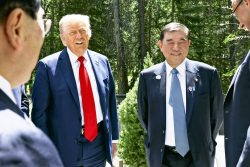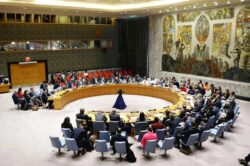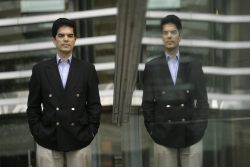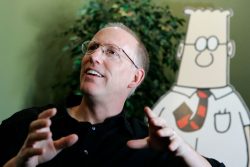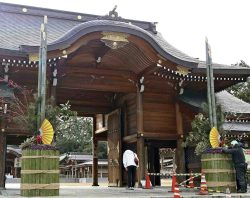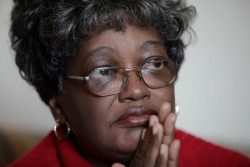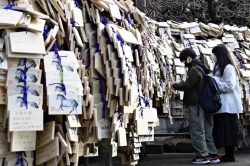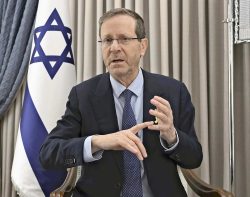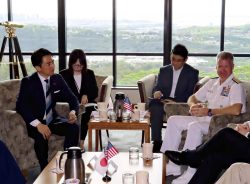G7 Hiroshima Summit / A-Bomb Witnesses Hope Memories of Devastation will Inspire G7 Efforts for Peace

Masaaki Tanabe, standing in front of the Atomic Bomb Dome in Hiroshima, says he wants Group of Seven leaders to understand what happened at ground zero in the city in 1945.
11:44 JST, May 7, 2023
Japan is set to host a Group of Seven summit in the atomic-bombed city of Hiroshima later this month, amid concern over a rising threat that nuclear weapons could be used again. This is the final installment in a series focusing on what can be learned from atomic bomb survivors and others, while considering the ideals and realities of trying to achieve nuclear abolition.
***
The area around the Peace Memorial Park in the city of Hiroshima, where leaders of the Group of Seven nations will meet for a summit later this month, was once a downtown crowded with shops and private houses. A single atomic bomb destroyed that community.
One visible reminder of that reality is the Atomic Bomb Dome in the park, a building whose interior steel beams have stood bare and exposed to the sky in the decades since the blast.
“The dome is quietly telling us what happened on the day,” Masaaki Tanabe, an 85-year-old filmmaker in the city, said as he gazed at the dome. “The atomic bomb exploded there. I want the G7 leaders to imagine the vanished city and the lives that once existed there.”
The dome is what remains of the Hiroshima Prefectural Industrial Promotion Hall, where local products and artworks were displayed. Tanabe’s house was near the east side of the building, so he used to play games like tag and hide-and-seek there as a child. Ryokan inns and liquor stores stood side by side in the area.
“The town was full of human warmth and vigor, and people there were like one family,” Tanabe said.
At the time the atomic bomb was dropped on the city, Tanabe, then 7 years old, was staying in Yamaguchi Prefecture, where he had been evacuated. Two days after the bombing, he returned to the city. In front of the industrial hall, blasted into ruin, he could only stand frozen. The remains of his mother and 1-year-old brother were never found. His father, who was exposed to radiation in the bombing, died on the day the war ended.
After graduating from university, Tanabe became involved in film production but avoided work related to the atomic bombing. But in 1997, when he turned 60, he started a project to reproduce the past cityscape around the industrial hall using computer graphics, wishing to convey what had happened in his hometown through film.
He collected testimony from local residents. One of them told him about finding a powdery white layer while digging up the earth in the park. “It was human ashes,” the person reportedly told him.
He produced six films based on the testimony of about 650 people. Four of them were screened at the United Nations headquarters in New York.
“The dome is the gravestone of those who died. I want the leaders to feel how many things the atomic bombing deprived people of,” Tanabe said emphatically. He is now putting in his final efforts into editing documents that will convey the dome’s history and the tragedy of the atomic bomb in order to convey the realities of ground zero.
Sadako’s paper cranes
The Children’s Peace Monument, which stands in the Peace Memorial Park, is modeled after Sadako Sasaki, an A-bomb victim who died at the age of 12. Suffering the effects of radiation exposure, she kept on folding paper cranes in the hospital where she was being treated for leukemia, believing that doing so would help her recover. With donations solicited by her classmates and others, the monument was erected in 1958.
Paper cranes have now become a symbol of the wish for the total abolition of nuclear weapons.
“The story of Sadako has spread from the statue,” her elder brother, Masahiro, 81, said.

Masahiro Sasaki speaks about his hope that paper cranes will move the world toward total abolition of nuclear weapons, in Nakagawa, Fukuoka Prefecture.
The two siblings — very young children at the time — were exposed to radiation in their home, 1.6 kilometers from ground zero. They survived the initial blast, but Sadako developed radiation-induced leukemia and died in 1955.
“Although she was unable receive sufficient treatment, she never complained or showed frustration,” Masahiro said. “On the day she died, she expressed appreciation, saying ‘Thank you.’”
With his sister’s thoughtfulness and warmth in his mind, Masahiro started sharing his experience in public around 2001.
Believing that true reconciliation requires breaking a cycle of hatred, he met with American veterans and also Clifton Truman Daniel, a grandson of former U.S. President Harry Truman, the leader who ordered the dropping of the atomic bomb on Hiroshima.
He also donated paper cranes that his sister folded to 19 locations both at home and abroad, including the USS Arizona Memorial at Pearl Harbor in Hawaii, which was attacked by Japanese forces in 1941. To share Sadako’s cranes as widely as possible across the world, he also began efforts to produce metal replicas of the last paper crane his sister folded.
Behind his continuing efforts is the belief that working on individual people’s hearts will eventually lead to worldwide peace.
Today, about 10 million paper cranes are delivered to Hiroshima each year from people in Japan and overseas. Masahiro feels that people’s awareness can be changed even little by little.
He has a sincere message to deliver to G7 leaders.
“If they look at the Atomic Bomb Dome, the Children’s Peace Monument and the paper cranes, they will understand in their heart of hearts that there should be no nuclear weapons in the world. I want them to act now with courage,” he said.
He believes the power of the atomic-bombed city will move the world.
"Politics" POPULAR ARTICLE
-

Japanese Language Requirement Eyed for Permanent Residency Status; LDP Plans Revisions of Laws on Foreigners
-
-250x167.jpg)
Japan Eyes Plan to Accept Up To 1.23 Mil. Foreign Workers by End of Fiscal 2028
-
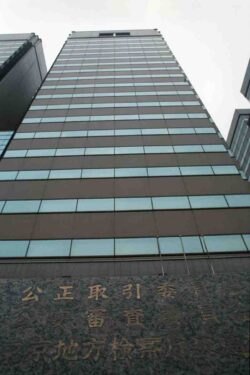
AI-Driven ‘Zero Clicks’ Phenomenon Threatens Democracy; News Outlets Must Be Able to Recover Costs, Stay Independent
-

Japanese Public, Private Sectors to Partner on ¥3 Tril. Project to Develop Domestic AI, SoftBank to Be Key Firm Involved
-

Japan’s Defense Ministry to Extend Reemployment Support for SDF Personnel to Age 65; Move Comes Amid Ongoing Labor Shortage
JN ACCESS RANKING
-

As Chinese Tourists Shun Japan, Hotels and Stores Suffer
-

Core Inflation in Tokyo Slows in December but Stays above BOJ Target
-

BOJ Gov. Ueda: Highly Likely Mechanism for Rising Wages, Prices Will Be Maintained
-

Osaka-Kansai Expo’s Economic Impact Estimated at ¥3.6 Trillion, Takes Actual Visitor Numbers into Account
-

Japan Govt Adopts Measures to Curb Mega Solar Power Plant Projects Amid Environmental Concerns


